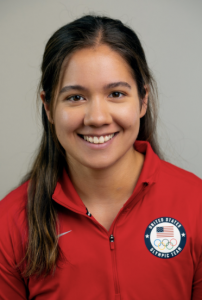Introduction
The introduction of Title IX had a considerably profound impact on women’s sports. This legislation, issued in 1972, ensured that female athletes would have the same opportunities as their male counterparts. As a result, the rise of women participating in sports and athletic activities has called for more attention to the unique biological needs of women throughout their entire life span. The reality is sports science has focused mostly on ways to optimize the performance of male bodies which has led to gaps in what we understand about the athletic potential of women. As an elite female athlete in the sport of weightlifting, I have seen how nutrition can influence performance: both my own, and that of my teammates. I have grown intimately connected to this particular subject matter as I pursue a career in nutrition and hope to be a part of the collaborative work it will take to ensure parity amongst all athletes.
With that said, the research has a long way to go but the main focus of this blog is to highlight some of the potentially unique nutrition considerations for the female athlete.
The Role of Nutrition in Athletic Performance
Proper nutrition plays a critical role in athletic performance, and female athletes have specific energetic and micronutrient needs. Additionally, failing to meet those needs has negative effects that will impact various biological processes unique to the female sex.
Understanding Energy Needs and Macronutrient Balance
Energy needs vary depending on body composition, activity level, and training intensity. Aiming to achieve a balance between carbohydrates, proteins, and fats is essential for optimal performance.
- Carbohydrates (CHO) are the body’s primary source of energy. The recommendations for CHO intake were founded on male studies and may not encompass the unique nutritional needs of women. For instance, the rates of gluconeogenesis (AKA the generation of CHO from a non-CHO source) are higher in the follicular phase than in the luteal phase, inferring there may be different nutritional needs between phases. However, there needs to be more research to conclude any sort of menstrual-based recommendations. For now, the research points to the importance of CHO intake post-exercise to replenish glycogen stores, including a 4:1 carb-to-protein ratio (1). In general, CHO intake should be the remainder of kcal leftover after protein and fat considerations have been evaluated.
- Protein is vital for muscle repair and growth. Currently, the ACSM recommends exercising women consume 1.2–2 g/kg/d of protein. There is some research that suggests protein catabolism is higher during the luteal phase so a slightly higher protein target range could be applicable. Generally speaking, athletes should focus on distributing their protein intake evenly throughout the day. The consumption of protein post-exercise has been shown to promote muscle protein synthesis, though the research is mixed when it comes to an “optimal window” for intake (2).
- Fats, including omega-3 fatty acids, are essential for hormone production and overall health. Currently, the recommendation is that athletes consume at least 20% of their dietary intake from fats (1).
Micronutrient Considerations for Female Athletes
In addition to macronutrients, female athletes need to pay attention to their intake of micronutrients, including vitamins and minerals that play a crucial role in performance and overall health.
- Iron: Iron deficiency is common among female athletes and can lead to decreased endurance and fatigue (1). High-risk groups include endurance athletes, those involved in restrictive eating/dieting, and athletes with heavy menstrual bleeding (1).
- Calcium and Vitamin D: Proper bone health is essential for athletes, and female athletes, in particular, are at a higher risk of developing osteoporosis (4). Consuming calcium-rich foods such as dairy products, leafy greens, and fortified non-dairy alternatives, along with adequate sun exposure for vitamin D, can support bone health.
- B Vitamins: B vitamins are necessary for energy production and metabolism. Foods like whole grains, legumes, nuts, and seeds are excellent sources of B vitamins and should be included in the diets of female athletes.
Hydration and Recovery
Proper hydration is critical for athletes to maintain optimal performance and overall well-being. Drinking enough fluids before, during, and after exercise helps replace fluids lost through sweat and prevents dehydration. It has been suggested that females may be at greater risk of dehydration-related consequences via sweating due to less absolute and relative total body water to begin with (3). Water is generally sufficient; however, electrolytes can be added with more intense sessions, summer months, and increased altitude. Do not begin workouts already dehydrated!
THE MOST IMPORTANT TAKEAWAY
Out of all the considerations mentioned in this blog, the biggest one that needs to be highlighted is meeting sufficient energy availability. Due to performance pressure and social stigma, female athletes are at a high risk of underfueling. Athletes need to work closely with a sports dietitian to ensure they are adequately fueling their bodies to not only optimize performance but to maintain overall good health.
About the Author

Socials @jourdannn_14 @herathlete
References
- Holtzman, B., & Ackerman, K. (2021, July). Practical Approaches to Nutrition for female athletes. Retrieved October 19, 2023, from Gatorade Sports Science Institute website: https://www.gssiweb.org/sports-science-exchange/article/practical-approaches-to-nutrition-for-female-athletes
- van Loon, L. J. C. (2014). Is there a need for protein ingestion during exercise? Sports Medicine (Auckland, N.Z.), 44 Suppl 1(S1), S105-11. doi:10.1007/s40279-014-0156-z
- Sims, S. T., Kerksick, C. M., Smith-Ryan, A. E., Janse de Jonge, X. A. K., Hirsch, K. R., Arent, S. M., … Antonio, J. (2023). International society of sports nutrition position stand: nutritional concerns of the female athlete. Journal of the International Society of Sports Nutrition, 20(1). doi:10.1080/15502783.2023.2204066
- MacKnight, J. M. (2017). Osteopenia and osteoporosis in female athletes. Clinics in Sports Medicine, 36(4), 687–702. doi:10.1016/j.csm.2017.05.006
